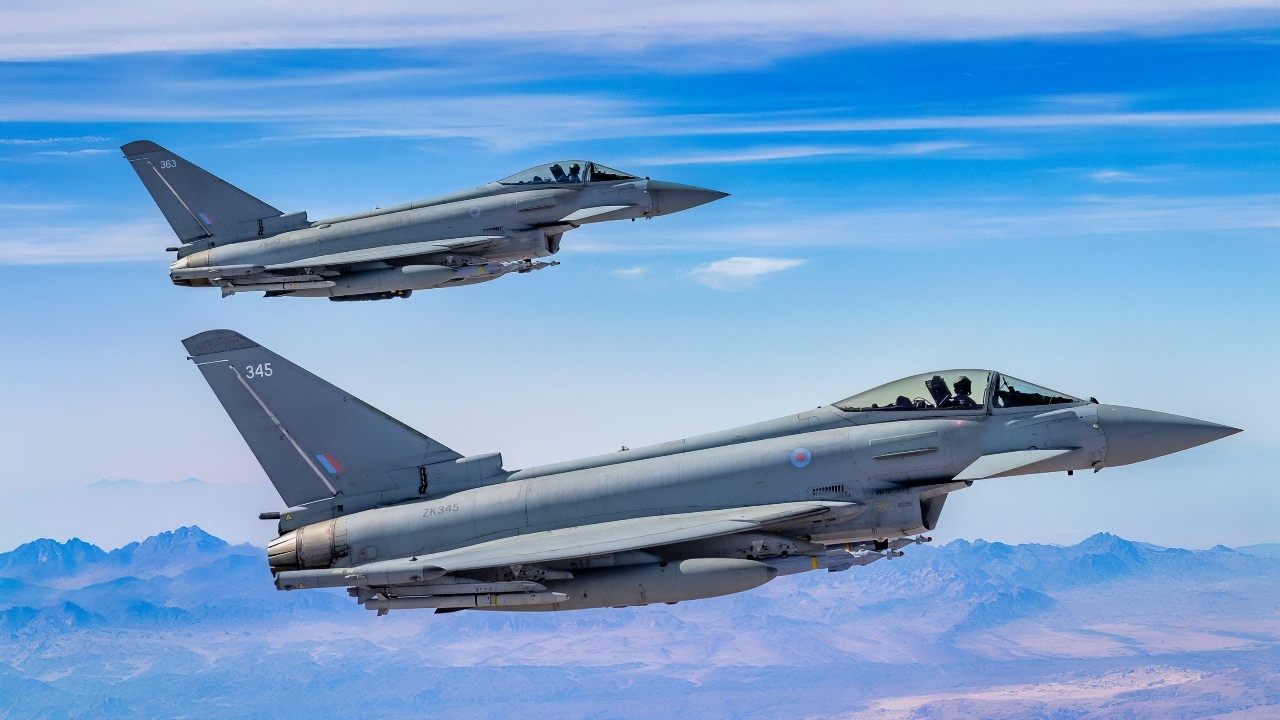Key Points and Summary – The Eurofighter Typhoon is one of Europe’s most successful 4th-generation fighter jets, prized for its speed and maneuverability.
-The Problem: Its lack of true stealth is a critical flaw in the modern era, making it vulnerable in highly contested airspace.
-The program now faces a new crisis: Airbus is warning that without new orders, the German production line will shut down in 2030, creating a decade-long capability gap.
-This comes as Germany’s new government controversially reversed course and approved the sale of 40 Typhoons to Turkey, highlighting the jet’s complex geopolitical role.
Eurofighter Typhoon: Europe’s Most Successful Fighter Jet Is Facing Extinction.
The Eurofighter Typhoon is a multinational fighter jet project centered on a European consortium made up of Spain, Italy, Britain, and Germany. The fighter now counts many more operators across the globe, including Kuwait, Saudi Arabia, Oman, and Qatar, and it has proven very successful.
Airbus, the maker of the jet, noted that it has logged 680 Eurofighter Typhoon orders, making the jet one of Europe’s most sought-after fighters in the post-Cold War era. There are several reasons for this success.
Many Upgrades Keep the Jet Moving Forward
The Eurofighter is a fourth-generation fighter – it does not incorporate the extensive stealth features of more advanced fifth-generation counterparts. Instead, the Eurofighter design prioritizes maneuverability, a quality greatly enhanced by the jet’s relaxed-stability design and fly-by-wire control systems, as well as its forward canards. Despite lacking dedicated stealth features, the jet has been steadily improved and upgraded.
In 2022, Germany started work on 38 new Eurofighters as part of the Quadriga initiative, which will send 30 single-seater fighters and 8 two-seat Eurofighters to the Luftwaffe. These jets are part of the Tranche 4 fighter standard, and they will replace Germany’s Tranche 1 fighters. The purchase will cost €5.4 billion, or around $6.4 billion.
The Eurofighter Typhoon as originally designed did not possess the ability to attack ground targets. In order to do so, the jet needed to be integrated with extra target-designation equipment. Later Eurofighter tranches addressed this shortcoming, thus crafting a much higher-quality jet.
One of the program’s enormous strengths is its multinational production, which leverages the abilities of Leonardo, Airbus, and BAE Systems to build the jet’s engines, cockpit, and fuselage, among other systems and subsystems.
In 2 Words: No Stealth
Though the Eurofighter is firmly rooted in the technologies and design strategies of fourth-generation aircraft, it has taken several measures to reduce its radar cross-section.
The jet features serpentine air intakes and S-shaped ducts that direct air to the jet’s two engines, shielding the engines’ blades from radar and reducing a significant source of radar bounce-back.
The airframe also features radar-absorbing materials that help to reduce radar reflections. In addition, some of the jet’s weapons can be carried within semi-recessed niches within the airframe, which partially hide them from radar.
Notheless, not being a real stealth fighter makes the plane in some respects obsolete as more and more F-35s and other 5th generation fighters take to the sky.
Further Export
In a significant about-face, the German government reversed its opposition to delivering Eurofighter Typhoons to Turkey. Germany’s Federal Security Council, a body roughly analogous to the United States National Security Council and headed by the German Chancellor, Friedrich Merz, approved sending 40 Eurofighters to Turkey, dropping opposition that was tied to Turkey’s human rights record.
Into the Future
The companies behind the design remain upbeat about the Eurofighter’s future, despite the advances made by stealth fighters and the expected arrival of sixth-generation aircraft.
“All of the maturing technologies above increase Eurofighter Typhoons survivability and superiority in the future battlespace,” the Eurofighter website says optimistically. “Additionally, improved defensive aid subsystems and enhance data connections allow direct updates to the airframe and with full control over mission data the Eurofighter Typhoon will reach higher levels of survivability.”
But considering the combat advantages granted by stealth, it seems unlikely that the Eurofighter Typhoon would excel in a forward, front-line aerial environment or in highly contested airspace. Instead, the jet could serve behind more advanced fifth- and sixth-generation fighters. From a rear position, it could fire long-range stand-off munitions against enemies.
Eurofighter production in Germany is scheduled to continue until 2030, following the delivery of the Tranche 4 aircraft of the Quadriga project. “The consequence would be a production gap of 10 years without orders for the domestic industry until the Future Combat Air System (FCAS) goes into operation in 2040,” Airbus explains.
“Without a follow-up order, the end of combat aircraft construction in Germany would be imminent – and with it the loss of jobs, tax revenues, cutting-edge technologies and expertise.
“In order to prevent this, the timely commissioning of the further development of the Eurofighter (Long-Term Evolution; LTE) and a fundamental decision on a follow-up procurement of new Eurofighters (Tranche 5) are necessary.”
What that LTE fighter might be is rather vague. Airbus says that, “The Long-Term Evolution capability development programme of the four core nations (Germany, Spain, Great Britain and Italy) provides for the modernization of important components, including the cockpit and adding more computing power. This will keep the Eurofighter at the cutting edge of technology.” But until more details emerge, whether a Tranche 5 fighter will be produced remains to be seen.
About the Author: Caleb Larson
Caleb Larson is an American multiformat journalist based in Berlin, Germany. His work covers the intersection of conflict and society, focusing on American foreign policy and European security. He has reported from Germany, Russia, and the United States. Most recently, he covered the war in Ukraine, reporting extensively on the war’s shifting battle lines from Donbas and writing on the war’s civilian and humanitarian toll. Previously, he worked as a Defense Reporter for POLITICO Europe. You can follow his latest work on X.
More Military
We Almost Touched the F-117 Stealth Fighter










